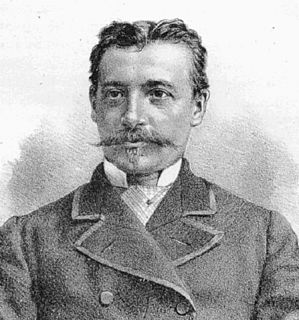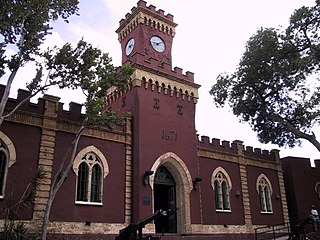
A transit of Venus across the Sun takes place when the planet Venus passes directly between the Sun and a superior planet, becoming visible against the solar disk. During a transit, Venus can be seen from Earth as a small black dot moving across the face of the Sun. The duration of such transits is usually several hours. A transit is similar to a solar eclipse by the Moon. While the diameter of Venus is more than three times that of the Moon, Venus appears smaller, and travels more slowly across the face of the Sun, because it is much farther away from Earth.

The Virgin Islands National Park is an American national park preserving about 60% of the land area of Saint John in the United States Virgin Islands, as well as more than 5,500 acres of adjacent ocean, and nearly all of Hassel Island, just off the Charlotte Amalie, Saint Thomas harbor.
Charles Edward Burton was a British-born Irish astronomer.

Louis Niesten (1844–1920) was a Belgian astronomer working at the Brussels Royal Observatory. In 1877 he observed Mars and created a detailed map of its surface features.

Hassel Island is a small island of the U.S. Virgin Islands, a United States territory located in the Caribbean Sea. Hassel Island lies in the Charlotte Amalie harbor just south of Saint Thomas and east of Water Island, with which it is part of the sub-district of Water Island.
Charles Green was a British astronomer, noted for his assignment by the Royal Society in 1768 to the expedition sent to the Pacific Ocean in order to observe the transit of Venus aboard James Cook's Endeavour.

Blackbeard's Castle is one of five National Historic Landmarks in the U.S. Virgin Islands. It is located in the city of Charlotte Amalie, on the island of St. Thomas. Erected in 1679 by the Danes as a watchtower to protect the harbor as well as Fort Christian, Blackbeard's Castle was originally called Skytsborg. It is located at the highest point of Government Hill. Skytsborg served as a very effective vantage point for Danish soldiers to spot enemy ships. Fort Christian is at sea level, thus making it ideal for thwarting attackers with cannon fire; however, the fort itself did not provide an ideal view of incoming ships entering the harbor.

Fort Christian is a Dano-Norwegian-built fort in Charlotte Amalie, Saint Thomas, U.S. Virgin Islands. Built 1672-1680, early in the first successful colonial establishment on the island, the fort served as a critical point of defense and government during the entire period of Dano-Norwegian, and later Danish, administration, which ended in 1917 with the sale of the islands to the United States. It currently holds the St. Thomas Museum, which holds artifacts and art of the Dano-Norwegian period. It was designated a U.S. National Historic Landmark in 1977.

The 1874 transit of Venus, which took place on 9 December 1874, was the first of the pair of transits of Venus that took place in the 19th century, with the second transit occurring eight years later in 1882. The previous pair of transits had taken place in 1761 and 1769, and the next pair would not take place until 2004 and 2012. As with previous transits, the 1874 transit would provide an opportunity for improved measurements and observations. Numerous expeditions were planned and sent out to observe the transit from locations around the globe, with several countries setting up official committees to organise the planning.

George Lyon Tupman FRAS was the Chief Astronomer for the British astronomical expedition to Hawaii to observe the 1874 transit of Venus.

U.S. Virgin Islands Governor's Mansion may refer to any one of the three official residences owned by the government of the U.S. Virgin Islands and provided to the Governor of the United States Virgin Islands. One residence is located on each of the three largest inhabited islands of this U.S. territory in the Caribbean. The U.S. Virgin Islands maintains more official gubernatorial residences than any other state or territory of the United States.

The Charlotte Amalie Historic District in Charlotte Amalie in Saint Thomas, U.S. Virgin Islands is a 165.3 acres (0.669 km2) historic district which was listed on the National Register of Historic Places in 1976.

Bordeaux, also known as Estate Bordeaux, is a historic former sugar plantation located on the West End of Saint Thomas, U.S. Virgin Islands. It was listed on the U.S. National Register of Historic Places in 1978. The listing included three contributing buildings and a contributing structure.

The Hamburg-America Shipping Line Administrative Offices, also known as United States District Courts Building, in Charlotte Amalie in Saint Thomas, U.S. Virgin Islands, was built in 1914. It was listed on the National Register of Historic Places in 1978.

Estate Hafensight, also known as Havensight, located south of Charlotte Amalie on Saint Thomas, U.S. Virgin Islands, was listed on the National Register of Historic Places in 1978. It is one mile (1.6 km) across Long Bay from Charlotte Amalie.

The Mafolie Great House, in Mafolie in the Northside subdistrict north of Charlotte Amalie in St. Thomas, U.S. Virgin Islands, was built in 1795. The estate was originally part of Estate Catherineberg, but was sold to Captain Sonderburg in 1962. It was listed on the National Register of Historic Places in 1978. The listing included three contributing buildings and a contributing structure.

The Estate Brewers Bay, located near the University of the Virgin Islands and John Brewers Bay Beach about 2 miles (3.2 km) west of Charlotte Amalie on Saint Thomas, U.S. Virgin Islands, is a historic sugar plantation which was listed on the National Register of Historic Places in 1978.

Estate Botany Bay, near Charlotte Amalie on Saint Thomas in the U.S. Virgin Islands, was listed on the National Register of Historic Places in 1976.

Estate Perseverance, near Charlotte Amalie on Saint Thomas in the U.S. Virgin Islands, was listed on the National Register of Historic Places in 1978. The listing included a contributing building and a contributing site on 2 acres (0.81 ha).

















